Buried Treasure
Nobody's Boy Remi
by Justin Sevakis,
A bit over a year ago, I was privileged to work on a series of DVDs for ImaginAsianTV and the anime studio TMS Entertainment of older shows that few fans remembered. The idea was to make a name for ImaginAsian by doing something very fan-oriented, while at the same time scoring some cheap television broadcast rights and hopefully making a buck for both us and TMS.
Unfortunately, the project ended badly for just about everybody. ImaginAsian wasn't really prepared for the amount of work it took to produce DVD boxed sets for long TV series. I ended up doing almost everything myself, even continuing to work on the discs as freelance for months after I quit the job. (They were my babies, after all.) Technical problems with the copy protection delayed the release for months. The company that was contracted to make the DVDs using a new process involving recordable discs ended up closing shop.
Producing these discs, I was literally pumping out six individual discs per month more or less by myself. In making DVDs, you really see a lot of these shows. Few are intended to be seen in marathon 5-hour authoring and proof-reading sessions that were the norm. At that rate, even the best anime becomes a horrible slog, a painful exercise in eating your favorite food until you want to puke. There are only a handful of shows that are good enough that you don't want to put a gun in your mouth somewhere around hour 4.
Of the shows I released, Nobody's Boy Remi was the longest. It was also the only one that I couldn't wait to keep working on.
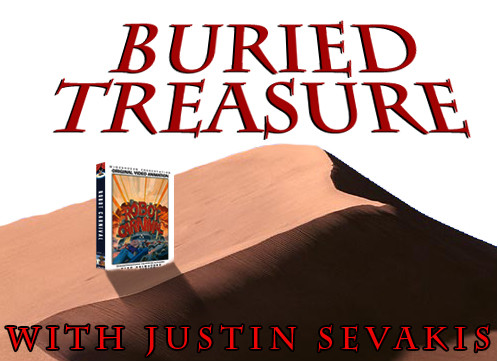
NOBODY'S BOY REMI
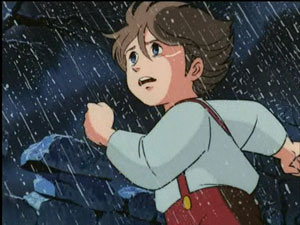 When we first meet Remi, he seems like a fairly normal, if lonely, peasant boy. Living with his mother in the French countryside, his best friend is the family cow Rousette. He plays in the fields collecting artichokes, and tries to help is mother whenever possible. Money is tight -- his father is off in Paris working and trying to provide for them. But one day, a co-worker stops by with devastating news: Remi's father has been injured on the job. He can no longer work, and is trying to sue the company.
When we first meet Remi, he seems like a fairly normal, if lonely, peasant boy. Living with his mother in the French countryside, his best friend is the family cow Rousette. He plays in the fields collecting artichokes, and tries to help is mother whenever possible. Money is tight -- his father is off in Paris working and trying to provide for them. But one day, a co-worker stops by with devastating news: Remi's father has been injured on the job. He can no longer work, and is trying to sue the company.
Remi's mother is forced to sell Rousette to pay for the suit (Remi is in tears over this). His father loses the lawsuit and comes home. Penniless, he makes a terrible decision: he is going to sell Remi. "You aren't my real son anyway," he cruelly informs the boy.
 The buyer is Vitalis, a stern looking man, rough from years on the road. A traveling street performer, he has three dogs (including its leader Cappy, named so because he always wears a hat) a monkey named Joli-coeur, and a bizarre looking outfit. Shellshocked and away from his (adopted) mother for the first time, Remi tearfully walks along with Vitalis to the next city.
The buyer is Vitalis, a stern looking man, rough from years on the road. A traveling street performer, he has three dogs (including its leader Cappy, named so because he always wears a hat) a monkey named Joli-coeur, and a bizarre looking outfit. Shellshocked and away from his (adopted) mother for the first time, Remi tearfully walks along with Vitalis to the next city.
The next few months are full of disappointments. Remi is given new clothes, but he is dismayed to find out that they're silly looking performance clothes. He makes a friend, but being a low-class street performer, isn't allowed to attend her birthday party. And the two walk until poor Remi's feet are so sore he can barely stand. Vitalis trains Remi in song and dance, and soon Remi is an integral part of the troupe. The gang is making enough money to eat regularly and even stay in modest hotels.
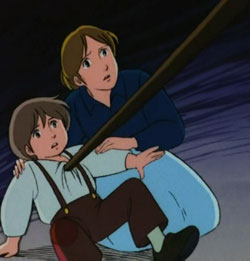 But any happiness is short lived. Winter comes, and with it come dangerous temperatures, illness, and myriad other disasters. The troupe has trouble making ends meet, and at one point Vitalis -- who has become quite close to Remi by this point -- must make the difficult decision to leave him in the care of an acquaintance. This acquaintance, little to his knowledge, uses the boys he takes in as slaves.
But any happiness is short lived. Winter comes, and with it come dangerous temperatures, illness, and myriad other disasters. The troupe has trouble making ends meet, and at one point Vitalis -- who has become quite close to Remi by this point -- must make the difficult decision to leave him in the care of an acquaintance. This acquaintance, little to his knowledge, uses the boys he takes in as slaves.
So many horrible things happen to Remi that those of us with a darker sense of humor may even find it amusing. (My intern Tom once suggested a drinking game: take a shot every time Remi learns how horrible life is; try to stand after a single episode.) But the bad times are so relentless that even our most cynical sensibilities are tested. By the show's halfway point many of the secondary characters are dead and Remi has gone through so much trauma and agony that our defenses come down and we're traumatized along with him. It's hard to get through those episodes, but few works of fiction so systematically chip away at our psychological defense mechanisms.
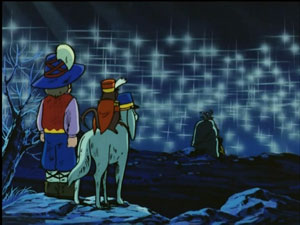 And then something changes. Just when Remi has hit absolute rock bottom and his continued existence is even in doubt, he makes a friend. Mattia, a street urchin who befriends Remi in an early episode, comes back as a permanent member of the troupe. I'll admit Mattia annoyed me at first: he's brash, loud, and a bit of a braggadocio. At the same time, he acts as a good counterbalance for Remi's Pollyanna-ish belief in humanity, and at the same time injects a bit of much-needed humor into the show. Together with Cappy, the two start bringing in more and more money. At the same time, they learn some surprising things about Remi's past, and filled with the hope of finding his real mother, they set out on a journey together.
And then something changes. Just when Remi has hit absolute rock bottom and his continued existence is even in doubt, he makes a friend. Mattia, a street urchin who befriends Remi in an early episode, comes back as a permanent member of the troupe. I'll admit Mattia annoyed me at first: he's brash, loud, and a bit of a braggadocio. At the same time, he acts as a good counterbalance for Remi's Pollyanna-ish belief in humanity, and at the same time injects a bit of much-needed humor into the show. Together with Cappy, the two start bringing in more and more money. At the same time, they learn some surprising things about Remi's past, and filled with the hope of finding his real mother, they set out on a journey together.
Remi was made in 1977, but doesn't look like it at all. This is partly due to the show's budget, which was quite high a TV series of its era. Where most series of this vintage suffer from low cel counts and thick pen lines, Remi looks almost theatrical quality for its era, which is no small feat considering that it runs for 51 episodes. The other reason is the unique stylistic choices that give the show a flavor all its own. By making near-constant use of multi-plane animation (first pioneered by Disney in the 1930s but seldom used in anime up to this point), everything is constantly moving even if there's little actual animation.
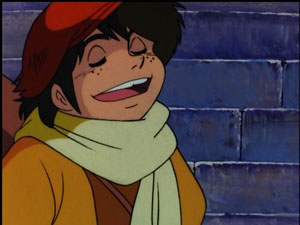 An early collaboration between one of my favorite anime directors Osamu Dezaki and Akio Sugino (who've worked together since on everything from the Blackjack OAVs to the recent Ultraviolet: Code 044), the show has a distinct post-psychedelic look, using the panning clouds and environments to create a surreal, sometimes nightmarish world for Remi to inhabit. Though the technique is most often used to save money today, here it's used to spectacular effect in how it captures the world as it must look to a child, who has no frame of reference for much of what he sees. Everything has an enhanced quality; colors seem more vivid, danger seems more menacing, and the strange seems downright creepy. Combined with Dezaki's feel for theatrical style dramatics (look for his trademark "snapshots" of particularly poignant moments) I was reminded of the progressive theater movement that took Tokyo by storm in the 70s.
An early collaboration between one of my favorite anime directors Osamu Dezaki and Akio Sugino (who've worked together since on everything from the Blackjack OAVs to the recent Ultraviolet: Code 044), the show has a distinct post-psychedelic look, using the panning clouds and environments to create a surreal, sometimes nightmarish world for Remi to inhabit. Though the technique is most often used to save money today, here it's used to spectacular effect in how it captures the world as it must look to a child, who has no frame of reference for much of what he sees. Everything has an enhanced quality; colors seem more vivid, danger seems more menacing, and the strange seems downright creepy. Combined with Dezaki's feel for theatrical style dramatics (look for his trademark "snapshots" of particularly poignant moments) I was reminded of the progressive theater movement that took Tokyo by storm in the 70s.
Remi is often confused for being a member of Nippon Animation's celebrated World Masterpiece Theater series of shows. This particular production has nothing to do with Nippon Animation or WMT, though the show was later remade with Remi as a girl in the early 1990s. (Indeed, this remake flopped so badly that it was cancelled, effectively ending WMT completely.) Despite being an adaptation of a Western children's book (by French author Hector Malot), the only thing Remi has in common with WMT is its languid pace. Which is fitting, being set in the 19th century and all.
 It's hard to imagine Remi and its ilk being intended for children; by Western standards the show would seem to either traumatize or bore them to tears. But Asian tradition suggests that empathy is an important trait to develop in children, and the whole reason many kids are turning to anime these days is that they're sick of Western children's television treating them like idiots. Its message is timeless, and to that end, reminded me of the Seikilos Epitaph, the oldest complete piece of written music in the world, dated from around 200 BC. Found on a tombstone in ancient ruins located in Turkey!, a translation of its lyrics reads:
It's hard to imagine Remi and its ilk being intended for children; by Western standards the show would seem to either traumatize or bore them to tears. But Asian tradition suggests that empathy is an important trait to develop in children, and the whole reason many kids are turning to anime these days is that they're sick of Western children's television treating them like idiots. Its message is timeless, and to that end, reminded me of the Seikilos Epitaph, the oldest complete piece of written music in the world, dated from around 200 BC. Found on a tombstone in ancient ruins located in Turkey!, a translation of its lyrics reads:
While you live, shine
Don't suffer anything at all;
Life exists only a short while
And time demands its toll.
Remi is more than just a depressing look at a child's life in the olden days, it has a message that we all need to hear: keep moving, no matter what. And enjoy life, even if it seems like suffering. After all, life is meant for living, and it's very short.
| Obscure-O-Meter™ | |
| A | Abundant. Available anywhere that carries anime. |
| C | Common. In print, and always available online. |
| R1 | US release out of print, still in stock most places. |
| R2 | US release out of print, not easy to find. |
| R3 | Import only, but it has English on it. |
| R4 | Import only, no English version. |
| R5 | Import only, and out of print. |
| R6 | Import out of print and rare. |
| R7 | Very rare. Limited import release or aired on TV with no video release. |
| R8 | Never been on the market. Almost impossible to obtain. |
Do digital fansubs exist*? NO | |
| Adapted from Soviet-Awards.com. *at the time of writing, to the best of our knowledge. | |
Completely unknown to American viewers (though well-loved in Central America and Asia), Remi was the least popular of the Anime Classics line, and only sold a handful of copies. Like the rest of the line, the discs were only in print for a few short months before they were unceremoniously pulled from circulation. Despite cramming up to 7 episodes on single-layer DVD volumes, I was quite proud of the video quality I managed to pull off on these discs. (For an ancient show, the elements were in remarkable condition, having recently been remastered.) I'm less proud of the subtitles, which had to be pulled from ancient type-written English scripts intended for dubbing. These were nowhere near accurate, and while we fixed most of the problems we completely missed others.
There's been talk of resurrecting the Anime Classics line among some of the parties involved in their initial release. I would love for that to happen, if for no other reason, so that more people could discover Remi, a true forgotten gem of anime history.
Screenshots © TMS. All rights reserved.
discuss this in the forum (45 posts) |